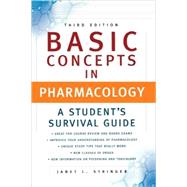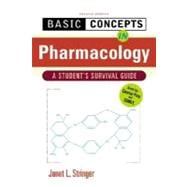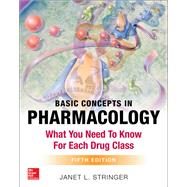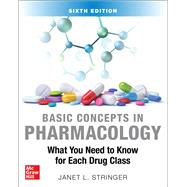Basic Concepts in Pharmacology: What You Need to Know for Each Drug Class, Fourth Edition What you Need to Know for Each Drug Class, Fourth Edition
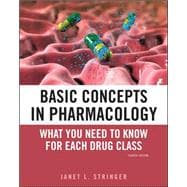
Basic Concepts in Pharmacology: What You Need to Know for Each Drug Class, Fourth Edition What you Need to Know for Each Drug Class, Fourth Edition
- ISBN 13:
9780071741040
- ISBN 10:
0071741046
- Edition: 4th
- Format: Paperback
- Copyright: 04/18/2011
- Publisher: McGraw-Hill Education / Medical
- Newer Edition
Rent
Sorry, this item is currently unavailable on Knetbooks.com
Note: Supplemental materials are not guaranteed with Rental or Used book purchases.
Extend or Purchase Your Rental at Any Time
Need to keep your rental past your due date? At any time before your due date you can extend or purchase your rental through your account.
Summary
A proven method for learning the most difficult-to-understand concepts in pharmacologyGreat for USMLE review!Basic Concepts in Pharmacologyprovides students with a complete framework for studying the fundamental principles of drug actions. This unique study system helps students set priorities, minimize memorization, and reduce stress.The book includes study techniques not found in any other book and details exactly what student need to know about each drug class to pass the course and the USMLE.Features Simplifies the learning process by presenting drugs by class Reinforces essential concepts and definitions Written in a conversational engaging style Organizes and condenses must-know drug information NEW larger trim size Numerous summary tables, illustrations, and boxes encapsulate key conceptsThe content you need to understand essential pharmacology material: Chapter 1. Where to Start; Part 1: General Principles; Chapter 2. Receptor Theory; Chapter 3. Absorption, Distribution and Clearance; Chapter 4. Pharmacokinetics; Chapter 5. Drug Metabolism and Renal Elimination; Part II: Autonomics; Chapter 6. Review of the Autonomic Nervous System; Chapter 7. Cholinergic Agonists; Chapter 8. Cholinergic Antagonists; Chapter 9. Adrenergic Agonists; Chapter 10. Adrenergic Antagonists; Part III: Drugs That Affect the Cardiovascular System; Chapter 11. Drugs that Improve Cardiac Contractility; Chapter 12. Antihypertensive Drugs; Chapter 13. Drugs that Treat Heart Failure; Chapter 14. Antiarrrhytmic Drugs; Chapter 15. Drugs that Affect Blood; Chapter 16. Lipid-Lowering Drugs; Part IV: Drugs Acting on the Central Nervous System; Chapter 17. Anxiolytic and Hynotic Drugs; Chapter 18. Antidepressants and Lithium; Chapter 19. Antipsychoyics or Neuroleptics; Chapter 20. Drugs Used in Parkinson's Disease; Chapter 21. Antiepileptic Drugs; Chapter 22 Narcotics; Chapter 23. General Anesthetics; Chapter 24. Local Anesthetics; Chapter 25. Introduction to Chemotherapy; Chapter 26. Inhibitors of Cell Wall Synthesis; Chapter 27. Proteins Synthesis Inhibitors; Chapter 28. Folate Anatgonists; Chapter 29. Quinolones and Urinary Tract Antiseptics; Chapter 30. Drugs Used in Tuberculosis and Leprosy; Chapter 31. Antifungal Drugs; Chapter 32. Anthelmintic Drugs; Chapter 33. Antiviral Drugs; Chapter 34. Antiprotozoal Drugs; Chapter 35. Anticancer Drugs; Part VI: Drugs that Affect the Endocrine System; Chapter 36. Andrenocortical Hormones; Chapter 37. Sex Steroids; Chapter 38. Thyroid and Antithyroid Drugs Chapter 39. Insulin, Glucagon and Oral Hypoglycemic Drugs; Part VII: Miscellaneous Drugs; Chapter 40. Histamine and Antihistamines; Chapter 41. Respiratory Drugs; Chapter 42. Drugs that Affect the GI Tract; Chapter 43. Nonnarcotic Analgesics and Anti-Inflammatory Drugs; Chapter 44. Immunosuppressives; Chapter 45. Drugs Used in Osteoporosis; Chapter 46. Toxicology and poisoning.






